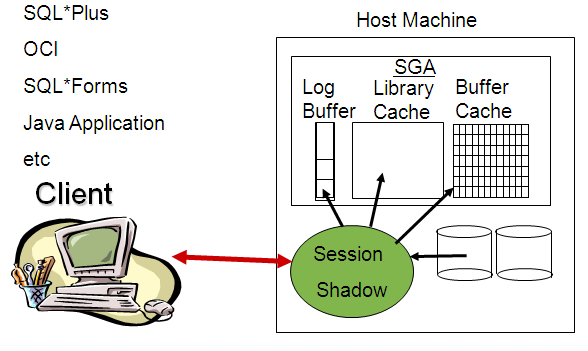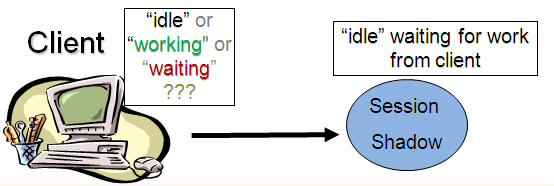Oracle: Network Waits
Oracle: Network Waits
Introduction
Unfortunately, what Oracle calls "Network Waits" have little to do with Network but and almost exclusively to do with the time it takes to pack messeges for the network before they are sent.
Client = you, the tool, sqlplus, application the shadow process is communicating to the client
Of the three waits, only "more data" is possibly related to network issues and that's not even clear, the other two are simply the time it takes to pack a message before sending it.
- SQL*Net message to client - time to pack a message (no network time included) possibly tune SDU
- SQL*Net more data from client - possible network issues, possibly tune SDU
- SQL*Net more data to client - time to pack a message (no network time included) possibly tune SDU
The same events exist, but where the client is the shadow process and another database plays the roll of shadow process:
- SQL*Net message to dblink
- SQL*Net more data from dblink - possible network issues, possibly tune SDU
- SQL*Net more data to dblink
SQL*Net Wait Events
SQL*Net message from client
- Idle Event
- Waiting for work from Client
- Includes network transmission times for messages coming from shadow
- Typically indicative of Client “think time” or “processing time”
- Example from Egor Starostin, http://oracledba.ru
- From a 10046 trace
- PARSING IN CURSOR #1 len=43 dep=0 uid=0 oct=3 lid=0 tim=1304096237
- hv=2707617103 ad='89a03e18'
- select * from all_objects where rownum < 20
- END OF STMT
- PARSE #1:c=0,e=143,p=0,cr=0,cu=0,mis=0,r=0,dep=0,og=1,tim=1304096209
- EXEC #1:c=0,e=744,p=0,cr=0,cu=0,mis=0,r=0,dep=0,og=1,tim=1304097036
- WAIT #1: nam='SQL*Net message to client' ela= 3 driver id=1650815232
- #bytes=1 p3=0 obj#=-1 tim=1304097096
- FETCH #1:c=10000,e=6903,p=0,cr=9,cu=0,mis=0,r=1,dep=0,og=1,tim=1304104057
- 1->WAIT #1: nam='SQL*Net message from client' ela= 721 driver
- id=1650815232 #bytes=1 p3=0 obj#=-1 tim=1304104865 # [non-idle]
- WAIT #1: nam='SQL*Net message to client' ela= 1 driver id=1650815232
- #bytes=1 p3=0 obj#=-1 tim=1304105319
- FETCH #1:c=0,e=627,p=0,cr=21,cu=0,mis=0,r=15,dep=0,og=1,tim=1304105524
- 2->WAIT #1: nam='SQL*Net message from client' ela= 253 driver
- id=1650815232 #bytes=1 p3=0 obj#=-1 tim=1304105818 # [non-idle]
- WAIT #1: nam='SQL*Net message to client' ela= 1 driver id=1650815232
- #bytes=1 p3=0 obj#=-1 tim=1304105867
- FETCH #1:c=0,e=63,p=0,cr=6,cu=0,mis=0,r=3,dep=0,og=1,tim=1304105900
- 3->WAIT #1: nam=' SQL*Net message from client ' ela= 1960753 driver
- id=1650815232 #bytes=1 p3=0 obj#=-1 tim=1306066946 # [idle]
- =====================
- PARSING IN CURSOR #1 len=21 dep=0 uid=0 oct=3 lid=0 tim=1306069444
- hv=2200891488 ad='89913b50'
- select user from dual
- END OF STMT
- PARSE #1:c=0,e=60,p=0,cr=0,cu=0,mis=0,r=0,dep=0,og=1,tim=1306069440
- The first two "SQL*Net message from client' are in the middle of cursor processing and are considered non-idle waits.
- The third "SQL*Net message from client" is between cursors and considered an idle event, ie we are waiting for the next command from the client.
SQL*Net message to client
- Time it takes to pack a message to be sent to the client
- Doesn’t include network timing
- see Tanel Poder's analysis of SQL*Net message to client
SQL*Net more data to client
- Same as SQL*Net message to client except this is for data that spans SDU packets.
- Wait represents the time it takes to pack data.
- Doesn’t include network timing
SQL*Net more data from client
- The only SQL*Net wait that can indicate a possible NETWORK problem
- Client is sending data to shadow that spans packets (think large data inserts, possibly large code blocks, large SQL statements)
- Shadow waits for next packet.
- Can indicate network latency.
- Can indicate a problem with the client tool
- Here is an example with ASHMON where the application server died mid-stream on inserts. The shadow processes were left waiting for completion of the message. You can see the regular load on the database on the left, then just past the middle the load crashes, and all that's left is waits on "SQL*Net more data from client"
- Possibly set SDU=32768 as well as setting RECV_BUF_SIZE and SEND_BUF_SIZE to 65536.
SQL*Net break/reset to client
- Error in sql statement
- Control C
- Usually highlights and error in application
- Example:
- CREATE TABLE T1 (C1 NUMBER);
- ALTER TABLE T1 ADD
- (CONSTRAINT T1_CHECK1 CHECK (C1 IN ('J','N')));
- ALTER SESSION SET EVENTS
- '10046 TRACE NAME CONTEXT FOREVER, LEVEL 12';
- INSERT INTO T1 VALUES (1);
- Trace File
- PARSING IN CURSOR #2 len=25 dep=0 uid=0 oct=2 lid=0 tim=5009300581224 hv=9816834
- 09 ad='8e6a7c10'
- INSERT INTO T1 VALUES (1)
- END OF STMT
- PARSE #2:c=0,e=2770,p=0,cr=2,cu=0,mis=1,r=0,dep=0,og=1,tim=5009300581220
- BINDS #2:
- EXEC #2:c=0,e=128,p=0,cr=0,cu=0,mis=0,r=0,dep=0,og=1,tim=5009300581418
- ERROR #2:err=1722 tim=512952379
- WAIT #2: nam='SQL*Net break/reset to client' ela= 31 driver id=1650815232 break?
- =1 p3=0 obj#=-1 tim=5009300581549
- WAIT #2: nam='SQL*Net break/reset to client' ela= 92 driver id=1650815232 break?
- =0 p3=0 obj#=-1 tim=5009300581662
- Unfortunately Oracle doesn't give much information about debugging unless you are trace. If you don't trace, the SQL won't be captured because from Oralce's point of view the problem statement isn't an acceptable SQL statement so there is no SQL ID to track down.
DBLINK SQL*Net Waits
- These waits are the same as
- SQL*Net message to dblink
- SQL*Net more data from dblink
- SQL*Net more data to dblink
- SQL*Net break/reset to dblink
Analysis and Tuning
- There isn't much to do on the Oracle side for tuning. You can try optimizing the SDU and SEND_BUF_SIZE and RECV_BUF_SIZE. For actually getting information on network speeds you will have to use something like
- ping
- tnsping
- network sniffer
SDU
- The default SDU can be set in the sqlnet. ora
- If it's not set, the default is 2048
- The max is 32768
- The default,or the value in sqlnet.ora, can be overridden in the tnsnames. ora and the listener.ora. The client and server negotiate the size aggreeing on the smaller of the two settings.
- (TDU – Transmission Data Unit – see note 44694.1 The TDU parameter has been deprecated in the Oracle Net v8.0 and beyond and is ignored. It is only mentioned here for backward compatibility.)
- tnsnames.ora
- V10G = (DESCRIPTION =
- (SDU=32768)
- (ADDRESS = (PROTOCOL = TCP)(HOST = fuji)(PORT = 1522))
- (CONNECT_DATA =
- (SERVER = DEDICATED) (SERVICE_NAME = v10g)
- ) )
- listener.ora
- SID_LIST_LISTENER =
- (SID_LIST =
- (SID_DESC =
- (SDU=32768)
- (SID_NAME = v10g)
- (ORACLE_HOME = /export/home/oracle10)
- ))
- Tracing
- sqlnet.ora
- trace_level_client=16
- trace_directory_client=/tmp
- trace_file_client=client.trc
- trace_unique_client = true
- trace_level_server=16
- trace_directory_server=/tmp
- trace_file_server=server.trc
- client.trc
- client_3582.trc:[12-JAN-2008 11:37:39:237] nsconneg: vsn=313, gbl=0xa01, sdu=32768, tdu=32767
- more from Jonathan Lewis at http://www.jlcomp.demon.co.uk/sdu.html
RECV_BUF_SIZE and SEND_BUF_SIZE
- see: http://download.oracle.com/docs/cd/B19306_01/network.102/b14212/performance.htm (or local copy)
- The recommended size for these buffers (from Oracle's docs) is at least
- Network bandwidth * roundtrip = buffer min size
- For example if the network bandwidth is 100mbs and the round trip time (from ping) is 5ms then
100,000,000 bits 1 byte 5 seconds
---------------- x ------ x --------- = 62,500 bytes
1 second 8 bits 1000
- tnsnames.ora
- V10G = (DESCRIPTION =
- (SEND_BUF_SIZE=65536)
- (RECV_BUF_SIZE=65536)
- (ADDRESS = (PROTOCOL = TCP)(HOST = fuji)(PORT = 1522))
- (CONNECT_DATA =
- (SERVER = DEDICATED) (SERVICE_NAME = v10g)
- ) )
- listener.ora
- SID_LIST_LISTENER =
- (SID_LIST =
- (SID_DESC =
- (SEND_BUF_SIZE=65536)
- (RECV_BUF_SIZE=65536)
- (SID_NAME = v10g)
- (ORACLE_HOME = /export/home/oracle10)
- ))
- sqlnet.ora
- RECV_BUF_SIZE=65536
- SEND_BUF_SIZE=65536






